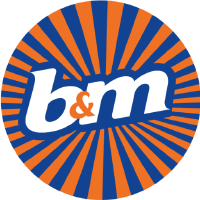Nachrichten |
| Datum / Uhrzeit |
Titel |
Bewertung |
| 20.11.25 05:03:33 |
Investoren können sich in der Qualität der B&M European Value Retail (LON:BME) Zahlen beruhigen. |
 |
|
**Haftungsausschluss: Der Text wurde mit Hilfe einer KI zusammengefasst und übersetzt. Für Aussagen aus dem Originaltext wird keine Haftung übernommen!**
**Zusammenfassung (ca. 500 Wörter)**
Trotz kürzlich gemeldeter schwächerer Gewinne ist der Aktienkurs von B&M European Value Retail (LON:BME) kaum verändert. Die Analyse deutet darauf hin, dass die aktuellen Gewinne zwar gedämpft sind, die Grundlagen des Geschäfts jedoch stark sind.
Ein wichtiger Faktor zur Bewertung der B&M-Performance ist das „Anrechnungskennlinie“. Diese Kennlinie misst die Übereinstimmung zwischen dem ausgewiesenen Gewinn und dem freien Cashflow (FCF). Sie wird berechnet, indem der FCF vom Gewinn abgezogen und das Ergebnis durch die durchschnittlichen bilanziellen Vermögenswerte dividiert wird. Eine negative Anrechnungskennlinie deutet darauf hin, dass der Gewinn eines Unternehmens durch den Cashflow erheblich gestützt wird – ein positives Zeichen. Umgekehrt deutet eine positive Anrechnungskennlinie darauf hin, dass der Gewinn überbewertet ist im Verhältnis zur verfügbaren Liquidität.
B&M’s Anrechnungskennlinie für das Geschäftsjahr bis September 2025 betrug -0,19. Dies deutet auf einen sehr starken Cash-Conversion-Zyklus hin, was bedeutet, dass der ausgewiesene Gewinn erheblich über dem tatsächlichen freien Cashflow liegt. Das Unternehmen erzeugte einen freien Cashflow von 545 Mio. GBP, weit über dem gemeldeten statischen Gewinn von 249,0 Mio. GBP. Dieser flache jährliche Cashflow-Wachstum ist bemerkenswert.
Der Artikel hebt das Potenzial für unterbewertete Gewinne hervor. Analysten prognostizieren zukünftige Gewinne, und ein interaktiver Graph (verlinkt im Originaltext) ist verfügbar, um diese Prognosen zu visualisieren.
Die gute Nachricht für die Aktionäre ist, dass B&M einen erheblichen freien Cashflow generiert hat, der die gemeldeten Gewinnzahlen validiert. Dies deutet darauf hin, dass das Potenzial des Unternehmens für zugrunde liegende Gewinne möglicherweise größer ist als was die aktuellen Gewinnzahlen vermuten lassen. Es ist jedoch wichtig zu beachten, dass sich der Gewinn pro Aktie (EPS) in den letzten zwölf Monaten verringert hat.
Eine umfassende Bewertung erfordert die Berücksichtigung mehrerer Faktoren. Der alleinige Fokus auf Gewinnzahlen ist nicht ausreichend.
Darüber hinaus betont der Artikel die Bedeutung der Risikobewertung. Anleger sollten sich der potenziellen Risiken bewusst sein, die mit der Investition in B&M verbunden sind, und drei identifizierte Bedenken hervorheben.
Der Artikel ermutigt zu weiterer Forschung und schlägt vor, Kennzahlen wie das Eigenkapitalrenditeverhältnis (ROE) und bedeutende Insiderbeteiligungen als ergänzende Informationen zu prüfen. Es ist wichtig, die Abmachungen von Simply Wall St zu beachten: Diese Analyse basiert auf historischen Daten und Analystenprognosen, stellt keine Finanzberatung dar und berücksichtigt keine individuellen Anlegersituationen. |
| 13.11.25 09:08:11 |
Die B&M-Marge sinkt trotz Umstrukturierungsversuchen. |
 |
|
**Haftungsausschluss: Der Text wurde mit Hilfe einer KI zusammengefasst und übersetzt. Für Aussagen aus dem Originaltext wird keine Haftung übernommen!**
**B&M gibt enttäuschende Gewinne bekannt und setzt Umstrukturierungsmaßnahmen um.**
Das Unternehmen gab außerdem eine Personalversammlung bekannt, um die Leistung zu verbessern, nachdem die Umsätze in der jüngeren Vergangenheit schwächer waren. Am Donnerstag teilte B&M European Value Retail mit, dass die Vorjahres-Vorsteuergewinne um 55,6 % auf 75 Millionen Pfund für die sechs Monate bis zum 27. September fielen, verglichen mit dem Vorjahr.
Die Umsätze des Unternehmens stiegen um 4 % auf 2,75 Milliarden Pfund. Im Vereinigten Königreich stiegen die Gesamtumsätze um 3,5 %, wobei die Verkäufe im Vergleich zum Vorjahr um 0,1 % stiegen.
Die Geschäftsleitung sagte, dass der im letzten Monat gestartete „Zurück zu den Grundlagen“-Plan Fortschritte macht, mit bereits stattfindenden Preisanpassungen. Das Unternehmen hat sein Preisangebot „verschärft“ und eine Reihe von Preisnachlässen angeboten. B&M hat außerdem seine Produktpalette in zahlreichen Kategorien erheblich reduziert, um seine Abläufe zu vereinfachen und Kosten zu senken.
Tjeerd Jegen, der dieses Jahr zum Chefexecutive ernannt wurde, sagte: „Unser Plan zur Rückbesinnung auf die Grundlagen geht voran und wir ergreifen entschlossene Maßnahmen, um unsere Einzelhandelsleistung zu verbessern und unsere finanzielle Leistung wiederherzustellen.“
“Während die vollständigen finanziellen Vorteile im Laufe der Zeit entstehen werden, bin ich zuversichtlich, dass unsere Maßnahmen ein nachhaltiges Wachstum der vergleichbaren Umsätze im B&M UK wiederherstellen können, was unsere oberste Priorität ist und, auf mittelfristiger Basis, niedrige zweistellige UK-angepasste Gewinnmargen als Ergebnis sein werden.” |
| 05.11.25 08:12:12 |
Die großen Investoren könnten jetzt heftige Maßnahmen ergreifen, nachdem B&M European Value Retail S.A. um 9,4% gefal |
 |
|
**Haftungsausschluss: Der Text wurde mit Hilfe einer KI zusammengefasst und übersetzt. Für Aussagen aus dem Originaltext wird keine Haftung übernommen!**
**Zusammenfassung (600 Wörter)**
Dieser Artikel analysiert die Beteiligungsstruktur von B&M European Value Retail S.A. (BME), einem britischen Discount-Einzelhandelsunternehmen. Der Kernpunkt ist, dass institutionelle Investoren eine dominante Position einnehmen, 51 % der Aktien des Unternehmens besitzen und damit dessen Aktienkurs und zukünftige Richtung beeinflussen.
**Hauptbeteiligungsgruppen:**
* **Institutionelle Investoren (51 %):** Diese großen Investoren, einschließlich derer auf wichtigen Indizes, üben erheblichen Einfluss aus. Ein jüngster Rückgang des Aktienkurses um 9,4 % in Kombination mit einem einjährigen Verlust von 51 % hat bei diesen Institutionen Besorgnis geweckt. Sie prüfen wahrscheinlich einen potenziellen Verkauf, was sich negativ auf einzelne Investoren auswirken könnte.
* **Top 21 Aktionäre (50 %):** Die kombinierte Beteiligung der Top 21 Aktionäre festigt die Dominanz der Institutionen weiter. Dies unterstreicht das Fehlen von Kontrolle, die jede einzelne Person oder Organisation über das Unternehmen hat.
* **Capital Research and Management (10 %):** Dies ist derzeit der größte einzelne Aktionär und zeigt eine erhebliche Investition in das Unternehmen.
* **Allgemeine Öffentlichkeit (42 %):** Einzelinvestoren halten gemeinsam den größten Anteil der Aktien und bieten eine Gegenkraft gegenüber dem institutionellen Einfluss. Obwohl sie einzeln weniger mächtig sind, können sie gemeinsam die Richtung der Aktie beeinflussen.
**Insider-Beteiligung und Überlegungen:**
Der Artikel betont die Bedeutung der Insider-Beteiligung, insbesondere wenn Top-Management-Mitglieder ebenfalls im Vorstand sitzen. Eine hohe Insider-Beteiligung (ca. 120 Mio. £ an Aktienwert) zeigt eine Ausrichtung zwischen Vorstand und Aktionären. Der Artikel warnt jedoch davor, die Verkäufe von Insidern zu beobachten, was auf Änderungen der Strategie oder der Stimmung hindeuten könnte.
**Analyse der Beteiligung:**
Der Artikel schlägt vor, die institutionelle Beteiligung als einen entscheidenden Schritt bei der Einschätzung der potenziellen Performance einer Aktie zu betrachten, zusammen mit der Prüfung von Analystenberichten und möglichen Warnzeichen. Es ist entscheidend, anzuerkennen, dass institutionelle Investoren zwar in der Lage sind, Aktienkurse zu beeinflussen, aber nicht unfehlbar sind. Fehlurteile können zu raschen Kursrückgängen führen.
---
Would you like me to perform any specific edits or additions to the translation, or generate a summary of a different piece of text? |





